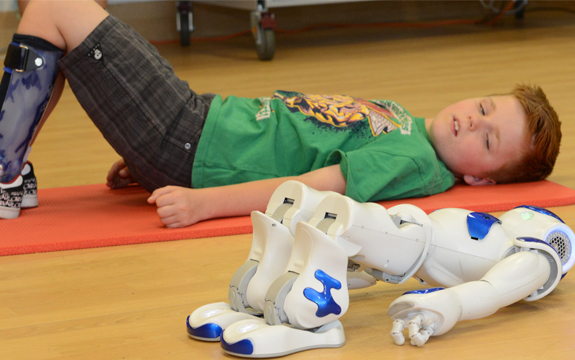A Geelong business is developing robots to assist children in rehabilitation, with surprising results. JOHN VAN KLAVEREN processes the data…
The future is robotic, if a father and son team behind a unique and innovative Geelong business is right.
And so far their excursion into the world of robotics and digital technology is proving a hit, especially in the fields of education and health.
But it’s less about robots of the Hollywood blockbuster variety and more about interactive technology, The Brainary co-founder Jonathan Kingsley says.
The business is the brains behind the innovative use of robotics in children’s rehabilitation, kick-starting the concept of using a humanoid robot to help young Victorians recover from major illnesses and injuries in a world-first trial at the Royal Children’s Hospital.
Jonathan says the project built on work the business had already done with assistive technology and children on the autism spectrum.
The humanoid robot, NAO (pronounced Now), is a 58 centimetre tall, friendly, cute robot that moves, recognises and hears people and responds.
Jonathan says NAO had revolutionary applications for healthcare, rehabilitation and special education.
“NAO helps break down communication barriers, especially for children on the autism spectrum, because it simplifies everything.
“With the rehabilitation project we’ve taken it a step further, working with Swinburne University and the TAC.”
Experts from Swinburne University worked with rehabilitation therapists from the Royal Children’s Hospital to program NAO to deliver tailored rehabilitation programs to young patients.
The project was funded by a $25,000 Transport Accident Commission grant.
NAO is being trialled on children with conditions ranging from brain and spinal cord injury to cerebral palsy. It has found that children are better motivated and engaged with their rehabilitation programs, primarily physiotherapy, when delivered by the talking robot.
Jonathan says The Brainary’s work with NAO showed it could be programmed to do just about anything.
“So we wondered how to get the robot engaged with motor accident victims,” he said. “NAO performs exactly the same each time and it doesn’t get bored or tired.
“It’s a great story of collaboration between the private, university and hospital sectors backed by government funding.
“For a fairly small Geelong-based business, it’s great to be working with the likes of Swinburne, the TAC and Royal Children’s Hospital.”
Jonathan said Swinburne University would carry out further research into the benefits of the program.
“Anecdotally, the kids are really receptive to the robot and it helps to motivate them and so improve the quality of the rehabilitation.
“It’s partly the novelty but it’s also because it is amazing, it’s non-invasive and non-threatening, because NAO is smaller than most kids.
“The program is based on game play, engaging kids to have fun while doing rehabilitation. It takes it out of being a chore into something that’s fun.”
While NAO’s usefulness in rehabilitation has taken the spotlight, Jonathan says it has wider implications for education along with other aspects of assistive technology.
The Brainary has also developed a disability product called TapIT, an interactive learning station comprising a screen able to be easily moved around and adapted to various uses in the disability field.
It can be used for computer-based learning applications utilising the Internet, educational software or communication devices and can even be controlled through eye-tracking.
Noosa Library Service was the first Australian public library to recruit NAO to provide fun and practical robotics and computer programming training for adults and young people.
Named Dewey, he helps Noosa Library Service by presenting robotic demonstrations, programming workshops, cyber safety messages, storytelling and special appearances at all three branches.
“This type of technology can change lives, so it’s exciting to be involved in it,” Jonathan says.
“For instance, we helped a rehabilitation client to do even simple things like read a paper and make phone calls which she couldn’t do before.”
And when it comes to fears of robots taking over, Jonathan laughs.
“Part of what schools and other organisations are using NAO for is to teach programming, so when it comes to that, the programmers will always be in control.”










